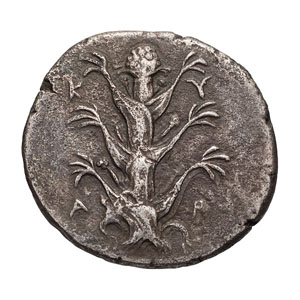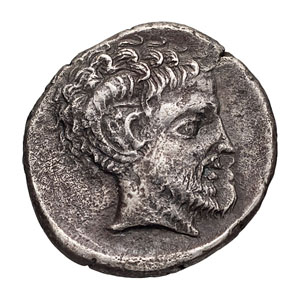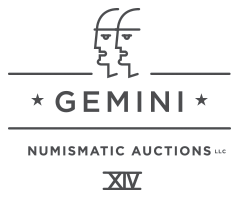|
|
 |
 |
 |
 |
 |
 Lot
# 337 - Auction is closed. Lot
# 337 - Auction is closed. Estimate: US$4000
/ Price Realized: US$4000 Estimate: US$4000
/ Price Realized: US$4000
|
 |
 Cyrenaica, Cyrene. Tetradrachm Cyrenaica, Cyrene. Tetradrachm
|
 |
|
 |

|
 
|
Cyrenaica, Cyrene. c. 435-331 BC. Tetradrachm, 12.93gg. (6h). Obv: Silphium plant with six leaves, K - V / P - A across field at corners of plant. Rx: Head of Ammon wearing ram's horn with short curly hair and scraggly beard. Porous surfaces but an impressive piece nonetheless. The obverse of this coin shows a very complete and elegant silphium plant. The reverse is very well struck with a sharp shadowing of an undertype that doesn't interfere with the image of the deity Ammon. BMC 73. The silphium plant is beautifully struck and absolutely complete. With some traces of an earlier overstruck type on the reverse. About EF.
Ex Frank L. Kovacs. Ex Nilus Coins. Ex G. Hirsch 275, 22 September 2011, lot 4150. Ex Schweizer Bankverein Zurich 33, September 1993, lot 463. Ex Christie's, 22 April 1986, lot 48.
The Greek cities of Cyrenaica, namely Cyrene and Barce, were one of the main suppliers of grain for the Mediterranean (in one instance, they even saved mainland Greece from starvation). As long as the grain trade flourished, Cyrenaica enjoyed prosperity. The revenues from the silphium trade were also important. Silphium, a plant that is likely to be extinct since antiquity, was used as medicine; its importance to the ancient economy of the Cyrenaica is underlined by the fact that both Barce and Cyrene used it as a badge on their coins. The other side of their coins displays a head of Zeus in a version specific to North Africa, with the horns of a ram, thus equivalent to the Egyptian god Amun. Zeus-Ammon, as the Greeks called him, was introduced to the Greek pantheon as early as the early fifth century BC. According to ancient sources the Boeotian poet Pindar who wrote victory odes for Cyrenian aristocrats donated a statue of Zeus-Ammon to a sanctuary (c. 450 BC). Its head might have been reminiscent of the relevant type of Cyrenian coins, and it is fun to imagine what Pindarís unsophisticated fellow-citizens might have thought about a statue of Zeus with the horns of a ram!.
|
|

